|
|
Ianina Prudenko is an associate professor of the Department of Cultural Studies on the National Pedagogical University in Kiev, curator of media arts forum New Media 2011 and also curator of unconventional educational program "Curves Mirror: History of Ukrainian media art in words and moving pictures." She briefly described actual topics and problems of young Ukrainian art in her text for Media Art Biennale WRO-2011. We present the Slovak version of this article in the magazine 3/4.

Sergiy Petluk, Dreams
Media art in Ukraine begun with video art. It was formed by the presence of TV (Vasil Tsagolov, Andriy Kazandzhiy, Glib Katchuk, Ilya Chichkan) and by post-modernist quotations of heritage of silent films (Alexander Roytburd, Glib Katchuk, Glib and Olga Kashymbekova, Ilya Chichkan and Kirilo Protsenko). Another important theme was corporeality (Alexander Hnilitsky, Natalia Filonenko, Alexander Roitburd, Anna Artemenko and Ivan Tsupka), simulacrum and illusory of the material world (Ilya Isupov, Alexander Gnilitsky, Lesia Zaiats), and for more example, situation of disabled people in Ukrainian society is an object of art investigation in videos of Glib and Olga Kashymbekova. A special place in the history of Ukrainian video art belongs to project of the independent art company Fund of Masoch called "Art in Space" (1993). It belongs to one of the first art works of the independent Ukraine, which was presented at the Biennale of Art in Sao Paulo (Brazil) in 1994. The video depicts a documentation of a project of the same name that took place on 25 January 1993, when, for the first time in outer space, the astronauts Sergei Avdeev and Andrey Soloviev displayed graphic works of Igor Podolchak on the board of the Russian space station Mir. Concept of this project was to bring to the outer space not only technological, but also artistic value of humanity.
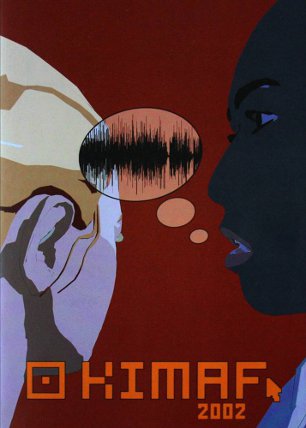
KIMAF, 2002.
Existence of the interactive art in Ukraine has a very interesting history associated with the activities of Soros Center for Contemporary Art in Kyiv and German cultural center Goethe Institute in Kyiv. In 1997 they invited Noering Hermann, the Director of EMAF (Electronic Media Art Festival) from Osnabruck, to Kyiv. Besides his lecture, seminars on computer animation took place, as well as presentation of works of German new media art and the exhibition Video sculpture in Germany. This visit resulted in establishment of Ukrainian institutions of media art – Info Media Bank and the festival KIMAF (Kyiv International Media Art Festival). Thanks to this institution and the festival, new media artists, such as Natalia Holibroda, Iliya Isupov, Olga Kashymbekova, Glib Katchuk, Anna Artemenko, Alexander Vereshchak, Margarita Zinets, Kirilo Protsenko, appeared in Ukraine. "Institution of Unstable Thoughts" was created here as well.
One of the most crucial representatives of Ukrainian net.art is the group Akuvido. It consists of two artists - Victor Dovhalyuk and Hanna Kutz, who began their art studies in Lviv Academy of Art (Ukraine) and continued in L4 Institut fuer Neue Medien (Berlin, Germany). Their first interactive project was Esse (1998), presented in Berlin. Later on, there were net.art projects City_interactive, Stand sound station, Decode, Jokonde XP, Web Wuerfel Werkstatt, Are you net-voyeur? All the works are available on the site www.akuvido.de. Akuvido are probably the world's most famous Ukrainian media artists, although they operate outside the Ukraine.
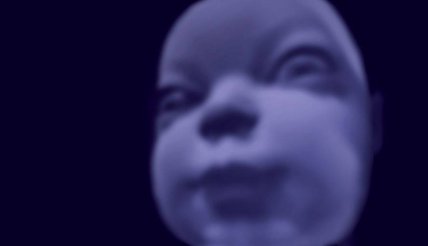
Jurij Kruchak a Julie Kostyeryeva, Baby, net.art, 2002.
The first net.art project, which was created directly in Ukraine, is the project BABY (2002) by Yuri Kruchak and Julia Kostyeryeva. the time of its creation the mortality rate in Ukraine was prevailing over the birth rate. Therefore the authors developed a web site, where anyone could "give birth" to their own child and support it and develop it for a period of 9 months.
In 2007 the net.art project The of the Khazars, or requiem for the theater was created by the director Anna Aleksandrovich. It was a first theatre performance in Ukraine, which was broadcasted online on the web site www.hazary.com.ua. During the performance, hypertext of Milorad Pavich was amended by comments of the audience, which were projected on the front wall of the theater hall. One of the spectators even came to the theatre with a notebook, so he became both a real and a virtual spectator at the same time. Besides that, all actors could use a notebook set on the stage to chat online with the audience, what was also displayed on the wall.
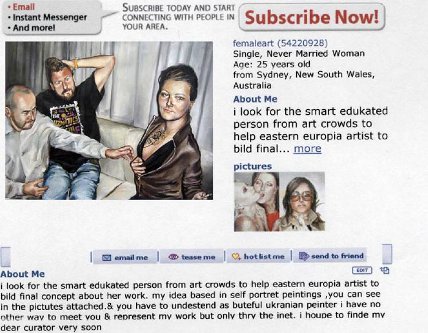
Masha Shubina, Digital narcissism, net.art, 2007.
Young Ukrainian artist Masha Shubina created a net.art project Digital narcissism (2007), where in order to present her artworks, she chose internet dating sites. She was interested in combining traditional painting and multimedia. Her goal was to meet curators, gallery owners, and museum directors thereby. But the only one, who responded, was a curator from Australia, most of the men and women responded with intimate suggestions. Masha’s parallel goal was to also promote her art in various parts of the world, establishing communication with the audience. She communicated with anyone who wrote her and saw her paintings at galleries. Digital narcissism can be still found today, originally it was created for an exhibition in a traditional exhibition space. It was presented in Ukraine in the Pinchuk Art Centre, in galleries in Russia, Germany, Italy and Great Britain.
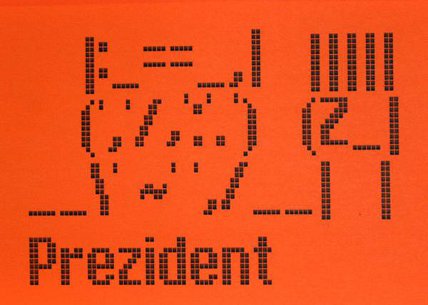
Roman Minin
In Kharkiv festival NonStopMedia in 2008, the project Mobile loneliness of the artists Hamlet Zinkivsky and Roman Minin was presented. The project consisted of the sms-art of Minin and 15 paintings of Zinkivsky, which portrayed people talking on mobile phone.
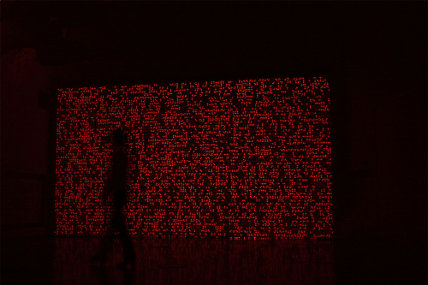
Тamara Hridyayeva, Representation, 2010.
The most difficult genres of new media art in Ukraine are nowadays occupied mostly by young artists from Lvov. It is possible mostly thanks to internships in Polish media institutions. At Biennale of Media Arts in Poznan 2010 the young artist Тamara Hridyayeva presented her project Representation. During the perception of this interactive work, the recipient was identified with an arrow that responded to the viewer by gaining gigantic dimensions. The Biennale of Media Arts in Wroclaw year on WRO was attended for example by Sergey Petlyuk; while another Ukrainian media artist from Lvov Andriy Linik presented himself at the festival „Mindware. Technologies of Dialogue" in Poland (Lublin). His intermediary work Aiolos would be very hard to create in Ukraine due to lack of media art institutions in the country, lack of finances and the unwillingness of galleries and art centers to work with such kind of contemporary art.
In Ukraine today, there is no profiled institution that would deal with education and support for young media artists. However, there is a number of festivals focusing on media art – NonStopMedia (Kharkov), Terra Futura (Kherson), Week of Contemporary Art (Lvov). In 2011, to celebrate the twentieth anniversary of media art in Ukraine, a media art forum New Media Ukrainetook place in Kyiv. Activities of Czech and Slovak media art were presented by Barbora Šedivá (The Brno House of Arts). The most important result of this meeting was the possibility to publish information about the Ukrainian media art through the collaborative research project and internet database Monoskop.
Despite all these problems today, a new generation of young media artists who grew up on a computer keyboard works in Ukraine. And there are also young curators and art theoreticians ready to interpret such a modern art form.
|